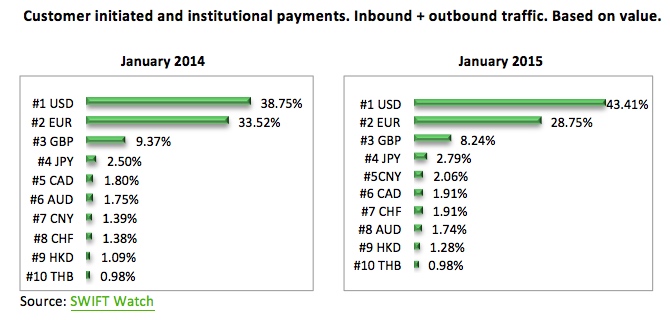April 2015: When conveying the value of things money is a common language that we all understand, from the most educated and developed regions, to the less developed areas of the world. While paper money hasn’t always been around, the concept of money has played a central role in developing our modern international economies and trade networks.
For thousands of years humanity has bartered the goods they had in surplus for those they lacked, a form of trade that is still in full swing in the 21st century. The first known “official” currency was introduced in Turkey in 600BC and, around 1661 AD, coins evolved into bank notes. In 1946 the first credit card was introduced and since the start of this century technology advances have disrupted the world of money more than once. In 1999 European banks started offering mobile banking while in 2008 contactless payment cards were issued in the UK for the first time.
Driven by mobile and internet technologies, we are now in the early stages of fundamentally changing how we handle and think about money, not to mention who is handling our money and transactions. Financial control is no longer only in the hands of the financial industry. Today entrepreneurial minds are connecting us to our (and others) money in new and innovative ways.
Let’s have a look at how the perception of money is redefining economic unions, trade and power – and at how innovative technology advances are disrupting the world of money and transactions.
Also see our slideshow presentation of The Future of Money
Redefining the world of money through economic unions and trade
It’s not the first time that we have stressed that information is power in a world driven by knowledge. But of course money is on the “= power” list too. While money seems like a simple idea the power it possesses is, from time to time, beyond imagination. Money equals wealth and wealth equals purchasing power. Money has started wars, stopped wars, changed political power, built cities and nations, and much more. The evolution of money and currencies has shaped our world and is continuing to do so. Worldwide there are currently 180 currencies recognized as legal tender: The chart below lists the world’s top 10 most used payment currencies by value.

Crossing borders, from East to West and North to South, trade is thriving in a globalized world, although rising currency volatility is making the costs of trading less predictable. To ensure and accelerate bilateral trade governments around the world are increasingly entering currency swap and free trade agreements. Currency usage is also impacting fundamental economic structures, with a growing number of monetary unions and cooperative agreements aiming to ensure price transparency, lower transaction costs, and encourage investment and economic growth, as well as global financial stability.
In Action!
Reshaping the global economic order: In July 2014, the BRICS announced the founding of the New Development Bank (NDB), headquartered in Shanghai. It aims to foster greater financial and development cooperation among the five BRICS economies and is an alternative to the World Bank and the IMF. Why now? The BRICS’ voting power in the IMF and the World Bank does not reflect their economic strength, making it difficult to increase their influence within those institutions. In addition, they are unhappy at the failure to elect a non-European director of the IMF that has consistently been run by Europeans since its creation in 1946. (Source: Forbes) The interesting question here is whether NDB is just an acronym with capital or if it is an actual rival to the World Bank and IMF? With the U.S. irritated by the potential founding membership by European nations led by the UK of the Asian Infrastructure Investment Bank – also a potential rival to the World Bank – is there also set to be a battle of economic institutions or are there more than enough investment opportunities globally for all? (Source: FT)
Redefining trade through currencies: Today around 80% of global trade finance is conducted in U.S. dollars.However, since 2000 China has sought to internationalize its currency, the renminbi (RMB), to facilitate its vast presence in global trade. In December 2013, the RMB overtook the Euro to become the second most-used currency in global trade finance (currency by value for documentary credit) after the US dollar. Its journey to becoming an international currency is still in the early stages, but with many countries interested in decreasing their reliance on the U.S. dollar, China is now entering more and more major deals in renminbi. From just 3% in 2010, the RMB was used to settle 18% of China’s total trade deals in 2014. Among other countries redefining trade though using alternatives to the U.S. dollar are Iran (will trade in currencies such as the Chinese RMB, Euro, Turkish lira, Russian ruble and South Korean won), Kazakhstan, Russia, Brazil, Australia, Turkey and UAE. (Sources: CNBC, Central Banking, Forbes)
Look out for…
Economic and monetary unions of the future: Price transparency, lower trade costs and increased financial stability are just some of the advantages of economic and monetary unions. An economic and monetary union has its downside too, e.g. economies move at different speeds, loss of economic sovereignty, and weakness of asymmetrical inflation targets. While the Eurozone crisis has put most people off currency unions, leaders in Africa and the Gulf countries are still working towards a unified currency union in their particular regions. South America, though, has shelved its common currency proposal made in 2011, following the ongoing troubles in the EU. (Source: Forbes, AL Monitor, The Economist)
U.S. dollar losing power as the global reserve currency: History shows that “reserve currencies” have a limited shelf-life and the U.S. dollar’s dominance as the world’s reserve currency has already lasted as long as Portugal’s and the Netherland’s did. There is much speculation about the U.S. dollar losing its reserve status to the Chinese renminbi. While this may not be an imminent threat, there is an ongoing trend towards decreased reliance on the dollar, in particular, in emerging markets (as noted above). At some point the renminbi will be ready to take its place as a global reserve currency. However that doesn’t necessarily mean it will replace the U.S. dollar. It could instead help to create a basket of reserve currencies comprising for example: US$, Euro and RMB. (Source: CNBC, Central Banking, J.P. Morgan)
When traditional banking no longer rules
In a world where free market capitalism is under fire, bank liquidity difficulties continue, and the public has lost trust in the traditional financial services industry, the world of finance is undergoing a radical shift. Traditional banking is under pressure and industry boundaries are blurring, aided by technology advances – and many banks have lost sight of the consumer in a landscape where the “old” banking rules no longer apply. It is no longer questionable whether new key players, from crowdfunding to microfinance to technology companies, have gained footing in the financial landscape. The question is rather who will be the key providers in the financial services market in the future?
In Action!
Crowdfunding for everyone: Today the crowd is in everything, almost. And if it’s not there now, it will be soon. Crowdfunding is reshaping the financial services industry in fundamental ways. Initially conceived as a simple, low-cost way to fund new business ideas as an alternative to using traditional financial service providers (many of whom were not interested in such investements), crowdfunding is now gaining real traction with new businesses and investors alike. Leading companies in this area include: Kickstarter, Indiegogo, Crowdfunder, RocketHub, Crowdrise, Quirky, Appbackr, and Invested.in. The concept is spreading to non-profit and public good projects, for example My ideal city Bogotá, which is using crowdsourcing and crowdfunding solutions to solve the problems of Bogotá in Columbia. An even more innovative way of crowdfunding focuses on an individual’s lifetime value in terms of earnings. One start up thinks this could be a new market: Upstart finds wealthy investors willing to give people hard cash in return for a stake in their future earnings.
The growing role of microfinance: In 2005 the UN Year of Microcredit raised awareness among investors about microfinance, as did the awarding of the Nobel Prize to Grameen Bank founder Muhammed Yunus. Since then the microfinance market, serving both individuals and micro- and small-enterprises, has grown at a rate of around 20% per annum. Currently there are 175 million clients served by microfinance, but the potential market is the 2.5 billion people – half the world’s adult population – who do not have an account at a formal financial institution. With sustainability being an increasing imperative for businesses and investors, the potential to make a positive impact on social and economic development is set to fuel continued rapid growth in the microfinance sector. In a recent interview with Global Trends, Symbiotics, one of the largest microfinance investment institutions with operations worldwide, suggests that there is significant interest from investors in the sector, but that “education of investors is important in terms of understanding both returns – which are not big generally in microfinance – and risks, as well as the potential for impact.” While the market looks set to continue to increase at 20% a year, a further challenge will be measuring real impact on the ground. (Source: Global Trends)
Look out for…
Democratizing P2P lending: It is undeniable. Peer-to-peer lending is becoming increasingly popular, growing rapidly in many countries. Popular P2P institutions are now funding loans in such large numbers that institutional investors and hedge funds are entering the peer-to-peer lending market with the risk of changing the industry from being “peer-to-peer” to “marketplace lending,” something the P2P purists may not like. Banks are also buying up loans from popular P2P site such as Lending Club and Prosper. More recently, banks and P2P companies have also started to enter partnerships, e.g. UK Santanderand Royal Bank of Scotland have entered into partnership with P2P companies. (Source: Financial Times). Big banks are capable of doing thing smaller competitors can’t and will most likely not disappear in the near future. With that being said, P2P lending is a real and legitimate option to traditional banking and will no doubt be a major force in the financial industry moving forward.
The faceless future of money providers: Istraditional physical banking on its last legs? In the US and Europe the number of bank branches has been declining rapidly during the last decade. Globally, banks are facing disruption from many directions as technology continues to permeate society. Looking forward physical bank branches will mostly likely still exist but in a very different form. Human bankers could be a rare sight as future banking lies in the physical co-existence with technology. Japan’s biggest bank Mitsubishi UFJ Financial Group has employed ‘Nao,’ a multilingual 5.4-kg humanoid robot, to deal with customers. Nao will start working on a trial basis in two branches from April 2015. Diebold’s, known for ATM solutions, new branch brainchild is a self-contained banking universe looking like an enclosed automated teller machine. Here customers can interact with a very human-like avatar to perform different transactions. If customers get frustrated with the avatar, software can detect a problem and switch the customer over to a real person. (Sources: The Guardian, CNBC)
The digital revolution – the cashless or less-cash society?
Despite predictions and trends around the digital world of payments and money, a transformation to a cashless society is not likely to happen in the near future. A better term may be the less-cash society: Why? Even in a world of digitization there will always be some people, e.g. babysitters, drug dealers, prostitutes, dog walkers and anarchists, who prefer to live in the underground economy that only works with cash. The more law-abiding and tax-paying part of the population, however, is increasingly being exposed to, if not dragged into, a world of electronic transactions, passwords and digital currencies – a world where physical paper money no longer rules and the traditional financial system is no longer the sole provider.
As more and more financial counseling and transactions take place in cyberspace the issue of security is rising. Are we willing to risk it? Do we dare to trust our personal finances to the web? Many of these concerns are valid, as criminal activity has become one of the 21st century’s growth industries, from identity theft to fraud to money laundering to cyber attacks.
In Action!
Where bartering is money: Business bartering has been around for a while (Pepsi conquered the USSR by exchanging the soft drink for vodka in 1990), but the pace is rapidly increasing. Today, at barter exchanges across the world, professionals from doctors to electricians are trading their services for goods, services or “trade credits” which can then be used to pay for business expenses whether printing, advertising or travel. Meanwhile, corporate barter firms, the intermediaries in barter transactions, have flourished, helping companies to create value from assets which may no longer fit their strategy, may not be working at capacity or are no longer needed. Honda, Kia and Subaru have bartered cars for media trade credits. Haymarket Exhibitions made part payment for advertising using tickets to their exhibitions. Lufthansa has bartered real estate for media credits and aviation fuel. (Source: The Exploding Business of Bartering) Look around your organization. How can you use barter to reduce costs, enhance revenues, build awareness or otherwise expand the pie?
From mobile to wearables payment: Mobile payment concepts are constantly developing, with technology advances changing the payment universe as we know it. Disruptive innovations that allow you to pay with your mobile handset, such as Apple Pay, were introduced in the U.S. in 2014 and are a huge success. Contactless payment solutions could take us a step further towards getting rid of the security and convenience disadvantages of the traditional credit card. Some believe that the wearable revolution will be the next big disruptor in the mobile payment landscape. UK bank Barclays is one player that has been experimenting with a number of mobile, wearable and online payment systems to win consumers in the digital age: Click here for 7 wearable payment innovations from Barclays. But what kind of payment solution do consumers prefer? According to emarketer more than two-thirds of US smartphone owners say they prefer to use a wearable device over a mobile phone to make in-store payments.
Look out for…
Where money is digital only – crypto currencies: It does sound like something from a sci-fi movie. But virtual currencies are “for real” if not physically real – in fact, there are more than 500 different kinds with a market value of US$4.7 billion as of mid-March 2015. The biggest crypto currency is Bitcoin with a market value of US$4.095 billion. Despite representing value crypto currencies are not recognized as money or currency from a legal perspective and presently have many disadvantages, e.g. lack of transparency, clarity and continuity; high dependency on IT and on networks; anonymity of the actors involved; and high volatility. Trust is what makes these currencies live! While digital currency is a huge advancement in terms of currency and payment technology, its adoption into governmental monetary systems is not something that will happen in near future, if ever. Even so, the technology underpinning digital currencies could potentially become the platform for future online payment systems. (Sources: Crypto-currency market capitalization, Virtual currency schemes – a further analysis)
Beacons for convenience: Indoor spaces do sometimes block cell phone signals which then makes location services on your mobile pretty much useless. Bluetooth Low Energy Technology or beacons seems to provide a solution to that. Beacons can detect how close a smartphone is to within inches. It is a new twist on location awareness and retailers are already in the first wave of adopting beacons to provide customers with product information, flash sales, personalized deals and coupons as well as to speed up the checkout process with its fully contactless payment system. However the beacon technology goes beyond retail. Check out this link to where else it can be deployed. (Sources: Payment Source, Business Insider). The question is if the consumer thinks this trend is cool or just creepy?
In May: Look out for trends in action on Managing the next generations at work




